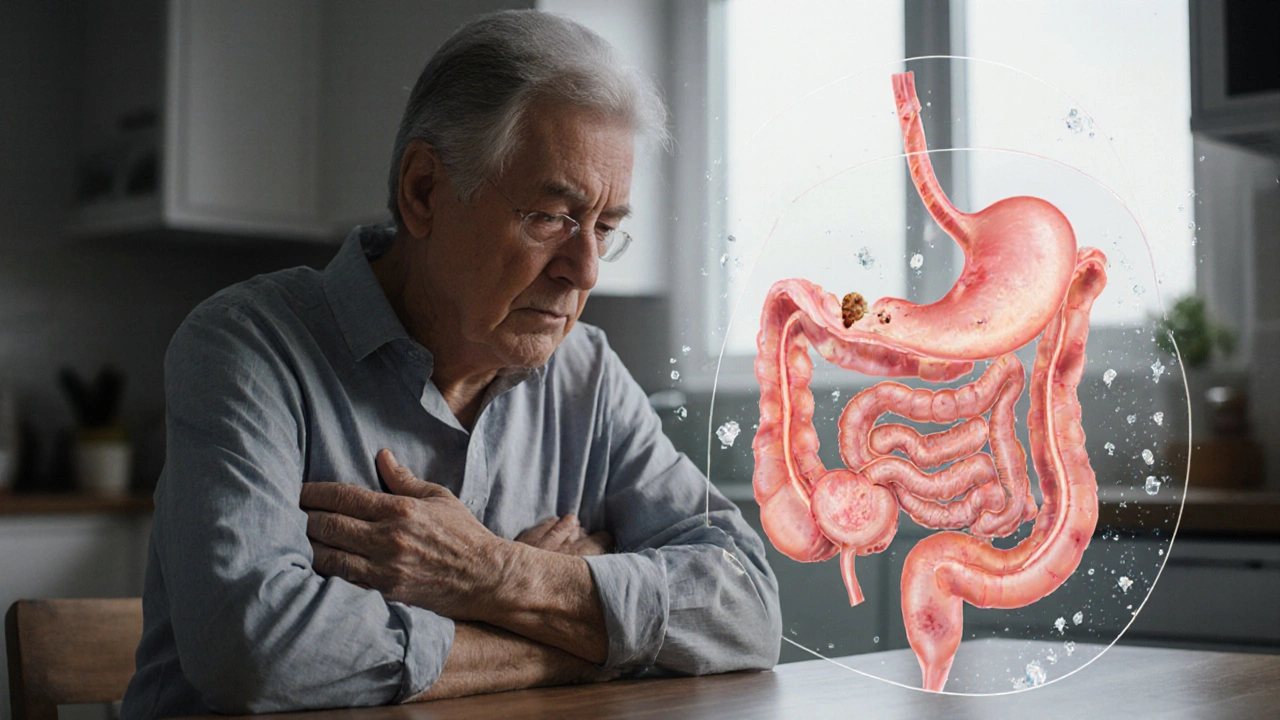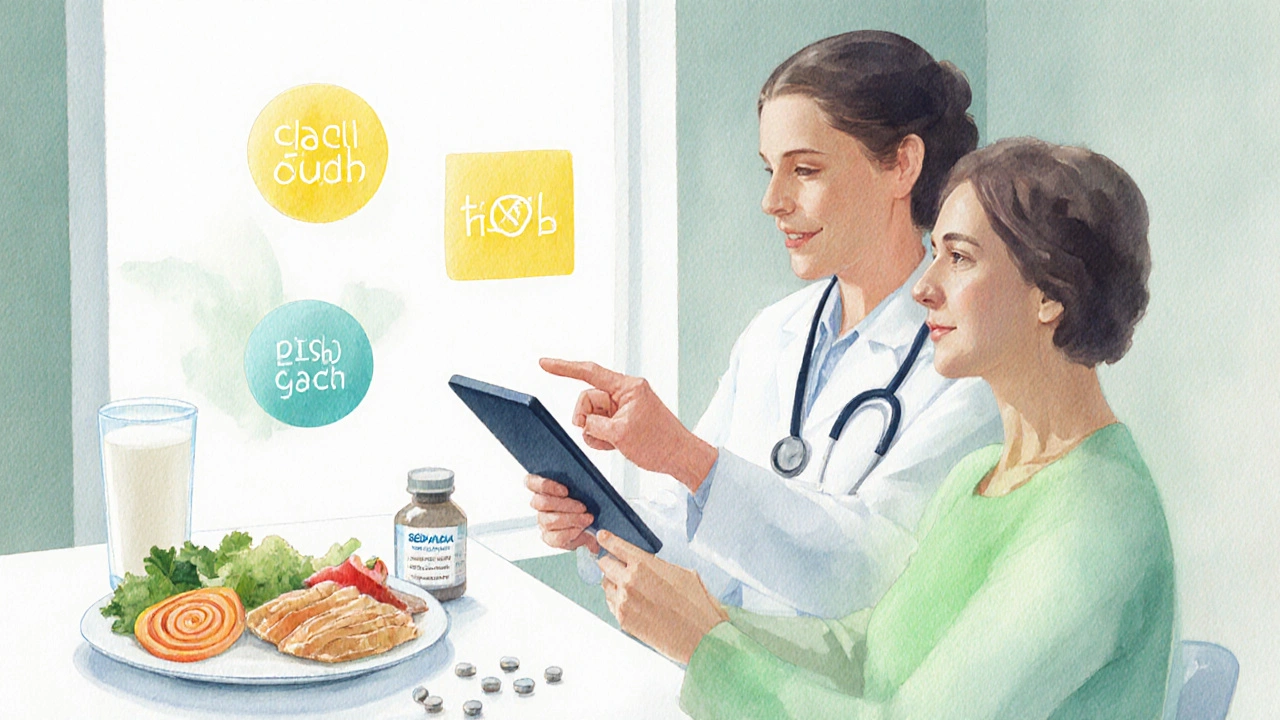Secondary Hyperparathyroidism & GI Symptoms Checker
Analysis Results
Secondary hyperparathyroidism often occurs in people with chronic kidney disease. It causes an imbalance in calcium, phosphate, and parathyroid hormone (PTH), which can lead to various gastrointestinal issues.
Common GI symptoms include diarrhea, constipation, abdominal cramping, peptic ulcers, and pancreatitis due to disrupted calcium regulation and gut motility.
When the parathyroid glands go into overdrive, they don’t just mess with bones-they can turn your gut upside down. Secondary hyperparathyroidism is a condition where the parathyroid glands secrete too much parathyroid hormone (PTH) as a reaction to low calcium levels, most often because the kidneys can’t keep up with waste and mineral balance. This excess hormone reshapes calcium handling, vitamin D activation, and phosphate clearance, creating a ripple effect that reaches the entire gastrointestinal (GI) tract.
Quick Take
- Secondary hyperparathyroidism usually stems from chronic kidney disease.
- High PTH drives calcium loss and alters gut motility, leading to diarrhea or constipation.
- Malabsorption of vitamin D and calcium can aggravate ulcer disease and pancreatitis.
- Treating the underlying kidney issue and normalizing calcium often eases GI complaints.
- Diet tweaks, phosphate binders, and active vitamin D supplements are first‑line tools.
What Triggers Secondary Hyperparathyroidism?
Chronic kidney disease (CKD) is the primary driver. As kidney function declines, it can’t convert vitamin D into its active form, 1,25‑dihydroxyvitamin D, prompting the gut to absorb less calcium. Low calcium signals the parathyroid glands to crank up parathyroid hormone, which in turn tries to pull calcium from bones and increase intestinal absorption.
Other contributors include prolonged vitamin D deficiency, high dietary phosphate, and certain medications (like loop diuretics). The net result is a feedback loop that keeps PTH levels high, even though calcium stays low or only mildly normal.
Calcium, PTH, and the Gut: The Biochemical Bridge
Calcium isn’t just for bones; it’s a key player in smooth‑muscle contraction, nerve signaling, and enzyme activation. The GI tract relies on calcium to coordinate peristalsis-the rhythmic waves that push food along.
When parathyroid hormone spikes, it does three things:
- Stimulates bone resorption, releasing calcium into the bloodstream.
- Increases renal reabsorption of calcium while dumping phosphate.
- Promotes activation of vitamin D, which boosts intestinal calcium uptake.
Because CKD hampers step two and step three, the body can’t rely on kidneys or vitamin D to restore calcium quickly. The gut ends up working harder, and the excess PTH can directly affect the enteric nervous system, leading to abnormal motility patterns.
GI Symptoms That Commonly Show Up
The gut’s response to altered calcium and phosphate balance falls into two broad categories: motility disturbances and mucosal irritation.
| Symptom | Underlying Mechanism | Common Co‑factors |
|---|---|---|
| Diarrhea | Excess calcium in the lumen pulls water into the intestine; PTH‑induced hypersecretion of pancreatic enzymes can exacerbate. | Phosphate binder use, dietary lactose intolerance |
| Constipation | Low serum calcium reduces smooth‑muscle contraction; chronic dehydration from CKD. | Low fiber intake, opioid analgesics |
| Abdominal cramping | Spasmodic peristalsis caused by calcium fluctuations. | Electrolyte imbalances (magnesium, potassium) |
| Peptic ulcer disease | Increased gastric acid secretion linked to high PTH and altered gastrin release. | NSAID use, H. pylori infection |
| Pancreatitis | Calcium‑induced premature activation of pancreatic enzymes. | Hypertriglyceridemia, alcohol |
Notice how many of these problems overlap with other CKD‑related issues, making diagnosis a bit of detective work.

Diagnosing the Gut‑Kidney Connection
Clinicians start with a thorough history: timing of GI complaints relative to CKD progression, diet, medication list, and any recent changes in phosphate binder dosage.
Lab work usually includes:
- Serum calcium (total and ionized)
- Phosphate levels
- Intact parathyroid hormone concentration
- 25‑OH vitamin D and 1,25‑OH2 vitamin D
- Creatinine and eGFR to stage CKD
Imaging (ultrasound or CT) is reserved for severe abdominal pain or suspected pancreatitis. Endoscopy may be ordered if ulcer disease is suspected, especially when pain persists despite medical therapy.
Managing the Dual Threat
Treatment has two fronts: correcting the hormonal imbalance and soothing the gut.
1. Targeting Secondary Hyperparathyroidism
- Phosphate binders: Reduce serum phosphate, easing PTH drive. Calcium‑based binders add extra calcium; non‑calcium binders (sevelamer) avoid hypercalcemia.
- Active vitamin D analogs (calcitriol, alfacalcidol): Boost intestinal calcium absorption, lowering PTH.
- Calcimimetics (cinacalcet): Trick the calcium‑sensing receptors into thinking calcium is higher, suppressing PTH secretion.
- Dialysis adjustments: More frequent or longer sessions help clear phosphate and improve vitamin D activation.
2. Healing the Gut
- Hydration: CKD patients often limit fluids, but mild, balanced intake can soften stools.
- Fiber: Soluble fiber (oats, psyllium) smooths bowel movements without adding excess potassium.
- Calcium‑rich but kidney‑friendly foods: Low‑phosphate dairy alternatives, fortified plant milks.
- Probiotics: Certain strains (Lactobacillus rhamnosus) have shown benefit in CKD‑related dysbiosis.
- Acid suppression: Proton‑pump inhibitors for ulcer pain, but use the lowest effective dose due to fracture risk.
Regular monitoring of calcium, phosphate, and PTH every 3-6 months lets clinicians tweak therapy before GI symptoms flare.
Real‑World Example
Mrs.L., a 58‑year‑old with stage4 CKD, started complaining of watery diarrhea after her nephrologist added a calcium‑based phosphate binder. Lab work showed a PTH of 850pg/mL (normal<65), serum calcium 8.2mg/dL (low‑normal), and phosphate 5.8mg/dL (high). Switching her binder to sevelamer lowered phosphate to 4.5mg/dL, and adding low‑dose calcitriol brought calcium to 9.0mg/dL while dropping PTH to 420pg/mL. Within two weeks, her stools firmed up, and abdominal cramping vanished. This case illustrates how fixing the mineral imbalance directly eased the gut issue.
When to Call a Specialist
If any of the following appear, bring in a gastroenterologist or nephrologist promptly:
- Severe, bloody diarrhea or melena (possible ulcer bleed).
- Unexplained weight loss >10% over a month.
- Recurrent pancreatitis episodes.
- Persistent constipation despite laxatives, raising suspicion of bowel obstruction.
Early specialist input can prevent complications like perforated ulcers or malnutrition, both of which worsen kidney outcomes.
Key Takeaways
Secondary hyperparathyroidism isn’t just a bone problem-it’s a systemic disturbance that can turn the gut into a vulnerable organ. By understanding the calcium‑phosphate‑PTH triangle, patients and clinicians can anticipate GI hiccups, test the right labs, and choose therapies that calm both the parathyroids and the intestines. Keeping an eye on diet, medication, and regular labs is the smartest way to keep the gut happy while protecting kidney health.

Frequently Asked Questions
Can secondary hyperparathyroidism cause both diarrhea and constipation?
Yes. High PTH can disrupt calcium handling in the gut, leading to excess water in the lumen (diarrhea) or reduced smooth‑muscle contraction (constipation). The exact symptom often depends on other factors like hydration, fiber intake, and medication side‑effects.
Is a low‑calcium diet advisable for someone with secondary hyperparathyroidism?
Not usually. The problem isn’t too much calcium; it’s that the body can’t absorb enough because of low active vitamin D. Most guidelines recommend maintaining adequate calcium (800‑1000mg/day) while controlling phosphate.
Do phosphate binders themselves cause GI upset?
Calcium‑based binders can cause constipation, while aluminum‑based or sevelamer can lead to nausea or mild diarrhea. Choosing the right binder based on the patient’s GI profile is part of personalized care.
How quickly can PTH levels be lowered?
With active vitamin D analogs and calcimimetics, a noticeable drop often occurs within 4‑6weeks. However, the full effect may take 3‑6months, especially in advanced CKD.
Should I avoid probiotic supplements?
Most probiotics are safe for CKD patients and can improve gut barrier function. Choose strains without high potassium or phosphate content, and discuss any supplement with your nephrologist.

Wow, the link between the parathyroid and gut really suprised me. I never thought hormone imbalance could cause both diarrhea and constipation at the same time. It makes sense though when you consider calcium's role in muscle contraction.
Great breakdown! Your explanation really helps demystify how secondary hyperparathyroidism can mess with GI motility. Keep spreading the knowledge 😊
The hormone‑gut connection is clearer now.
In a way, the body resembles a finely tuned orchestra, where the parathyroid glands are the conductors. When they over‑signal, every instrument-from bone to bowel-falls out of sync. This discord underscores the interconnectedness of our endocrine and digestive systems. It also reminds us that treating one organ in isolation may ignore the underlying symphony. 🎼
Actually, the primary driver isn’t just low calcium; phosphate retention in CKD also stimulates PTH release. Moreover, active vitamin D analogs can suppress that drive more effectively than calcium‑based binders alone. You might also consider that sevelamer, a non‑calcium binder, reduces phosphate without adding extra calcium, which can be a double‑edged sword for the gut. Finally, monitoring PTH every 3‑6 months is key-missed labs can lead to unnoticed GI flare‑ups.
Reading this article felt like opening a Pandora’s box of gut grievances that many CKD patients silently endure. It is heartbreaking to see how a hormone meant to protect bone can betray the intestines. It reminds me of the quiet battles waged in the colon when calcium levels swing like a pendulum. The literature often glosses over the fact that patients can suffer from both watery diarrhea and stubborn constipation in the same week. It is not just a medical curiosity but a daily source of discomfort and anxiety for those trying to maintain a normal life. The cascade of PTH, phosphate, and vitamin D creates a perfect storm that can inflame the gastric lining and even trigger ulcer formation. The pancreas is not spared either as calcium overload can prematurely activate enzymes leading to painful pancreatitis. The psychological toll of chronic pain and embarrassment from unpredictable bowel movements cannot be understated. It is a reminder that the body’s systems are not isolated silos but a tightly knit network. The role of diet, especially low‑phosphate yet calcium‑rich foods, becomes crucial yet confusing for many patients. The need for individualized binder therapy is evident as calcium‑based binders may worsen constipation while sevelamer may cause nausea. The importance of regular monitoring cannot be overemphasized because delayed adjustments allow GI symptoms to fester. The article’s clear tables help clinicians visualize the link but they do not capture the lived experience of patients waking up at night with abdominal cramps. It calls for a compassionate approach that treats numbers and symptoms with equal weight. Ultimately, addressing the hormonal imbalance is the key to restoring gastrointestinal harmony.
I appreciate how the piece connects lab values to real symptoms, making it easier to explain to patients during visits.
The practical tips on fiber and probiotic choices are spot on, especially for those juggling fluid restrictions. It’s good to see a balanced view that doesn’t overprescribe supplements.